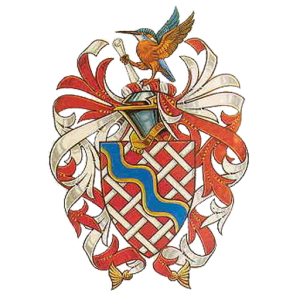
The Arms of the Parish of Sawston
Situated In Cambridgeshire , was granted by the College of Arms in London.The Coat of Arms comprises the Coat of Arms of the Huddleston family, for many years owners of Sawston Hall, Diagonally across, is a blue wavy band, representing the river Cam, from which much of the Village’s prosperity has been derived. The kingfisher is a local inhabitant, bearing a scroll of parchment or paper. First settled by Saxons The ancient village of Sawston has boundaries that were established before those of the Kingdom itself.Well- known since the eighteenth century for its leather, parchment and paper industries, the Village is still the largest in South Cambridgeshire, providing shopping facilities and employment for people in the surrounding area. In recognition of its origins (Sawston’s ancient name being Selsingtona), Sawston is twinned with Selsingen in Lower Saxony, Germany.
| The Parish Church:
This is the oldest building in Sawston with parts dating from about 1100. There may also have been a Saxon church on the site before this. Notable features include memorials to Elizabeth de la Pole, John Huddleston and several members of his family, Edward Towgood, 11-avis Teversham and to Edwin Daniel (Vicar in the time of Thomas Evans). The east window was restored in memory of Ronald Bircham (Vicar until more recently). The Church also contains several monumental brasses and a memorial to those who died in the World Wars and Korea. |
| Sawston Village College:
Sawston Village College was the brainchild of Henry Morris, Cambridgeshire’s pioneering Secretary of Education (1922-1954), and was the first of many such purpose built community colleges where the ethos was for teaching from ‘the cradle to the grave’ in a school with no barriers. It was opened in November 1930 by the then Prince of Wales who thought he was opening another Cambridge University College and was surprised when he found it was a school. The college has increased in size and has undergone vast building projects to provide up to date equipment and facilities for 11-16 education. Adult Education still features prominently in the calendar. The Village College also has a Sports Centre which is open to the public for many facilities including swimming, fitness and conditioning treatments. |
| Sawston Hall:
Sawston Hall is an Elizabethan manor house set in extensive ground and gardens. In 1553 when Edward VI died his half sister Mary Tudor was sent a false message asking her to return to London. On the way she received word that this was a trap, and on her way back to Norfolk spent the night as the guest of the Huddleston family at Sawston Hall. The Duke of Northumberland’s men set out to capture her but she escaped from Sawston disguised as a milkmaid, riding pillion behind a manservant and escorted by John Huddleston. Sawston Hall was set alight by the disappointed Duke’s men and Mary stated that she would rebuild the house when she became Queen. This she did by giving the stones of Cambridge Castle to the Huddleston family to rebuild the house. Sawston Hall was always a Catholic House and has several priest hiding holes within it designed by Nicholas Owen. |
| Town Peas:
In 1554 John Huntingdon left all his land in Sawston to his wife Joyce on condition that she sowed a two-acre field called Lenton field with white peas from which every poor person in the parish could gather a combe (four bushels) to sustain themselves. After Joycc’s death his estate would continue to fund charitable enterprises in Sawston including the cultivation of the pea field. Although the venue has changed, the tradition still lives on with the help of Huntingdon’s Charity and Syngenta. Traditionally the villagers assemble around the field on a day in July (locally advertised) and wait for the whistle to blow before rushing onto the field to gather their peas. In earlier times even the schools finished early to allow the children to take part and the whistle was usually blown by the village Police officer. |
| Leather:
By the beginning of the eighteenth-century leather making was a well-established industry in The Old Yard, Sawston. When chamois leather manufacture came in the middle of the nineteenth century much of the work was done by people in their own homes and boys were drafted in from the Linton Workhouse to work in the yard. In 1879 The Eastern Counties Leather Co Ltd was started by local clergy and businessmen to provide fairer and better working conditions. Glove making also started about this time. Today the work still continues within the village and employs many local people. |
| Paper Manufacture:
In 1664 Richard Allen started his paper making business in Dernford Mill. This had previously been used for cloth making and by the eighteenth century was well established and several mills had been set up. By 1851 Borough Mill made much of the paper used throughout the country and in 1917 it was bought on behalf of Spicer Bros Ltd. In 1920 they set up another new company called British Waxed Wrappings and in the 1930’s also set up a company producing Dufaycolour film. Spicers also had farmland around the factory and won championships with their pigs and cattle. Spicers played an important part in village life by providing housing and transport to and from work for their workers. Harry Spicer also provided the land that the Village College is built upon. During this time his wife also set up a maternity and infant welfare centre. In 2007 Spicers very kindly sold their sports ground in New Road to the Parish Council to allow sports to continue on the ground in perpetuity. |
For a more detailed history of Sawston, Dr David Bard, a Sawston Parish councillor, suggests that readers of this page who may want to know more, please click on the links shown below, which will link to the Victoria County History section on Sawston.
https://www.british-history.ac.uk/vch/cambs/vol6/pp246-263